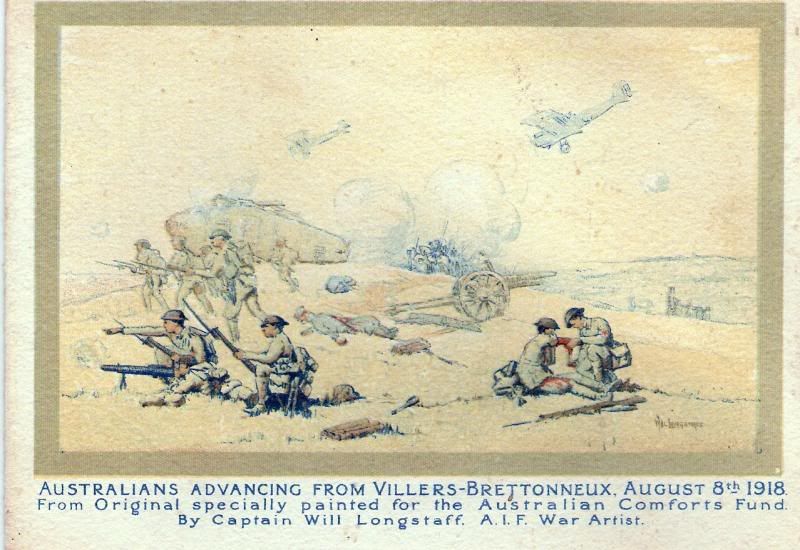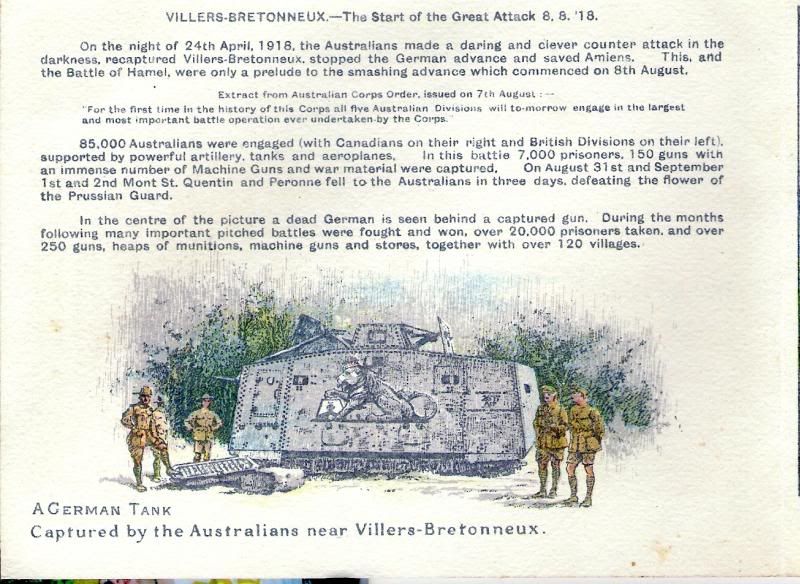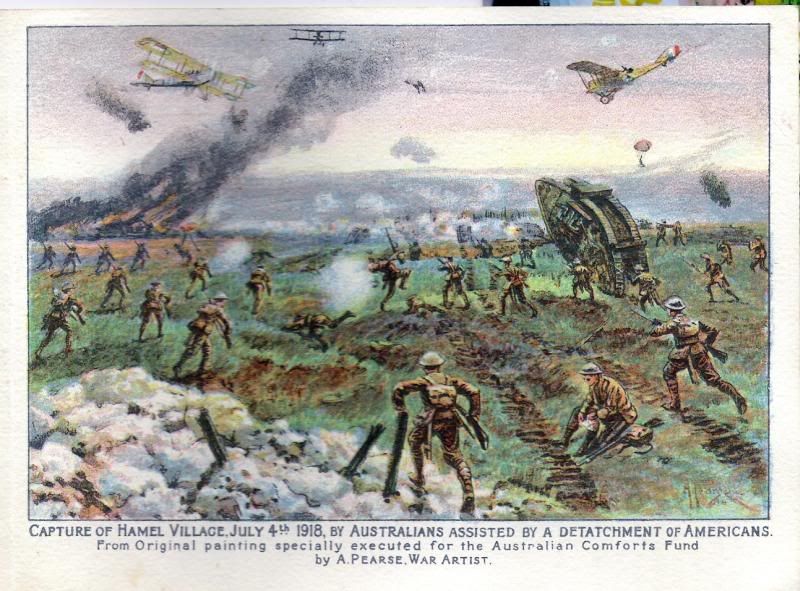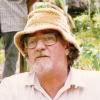Thursday, May 06, 2010
More about Gwendolyn's Travel
Sorry about the mismatched sizes on screen ; I had to download it as two images, and despite much fiddling I cannot get them to line up properly.
Sunday 9th: Went down to Lutwyche cemetery armed with a location map and all the numbers - Portion 13, Section 12, Grave No. 17. Unfortunately, it appears that Gwendolyn lies in an unmarked grave. I need to know a little more about the layout of the grave numbers before I determine exactly which bare plot belongs to her. There are quite a few bare grave plots in Sections 12 and 11.
Labels: Adelaide. Melbourne, Broome, Burketown, Darwin, Gwedolyn Vasco, Louis Vasco, Mandolin, Perth, Thursday Island, Vasco Loureiro, Wyndham
Thursday, March 18, 2010
Around The World On A Mandolin
An interesting reference was in the Argus of 6th August 1932, in an article entitled Bohemia in Melbourne: The Romance of Fasoli's by J Alex Allen. It appears that there was a time when did in Melbourne exactly what he did in California; sit in a bar or similar establishment and draw caricatures of other patrons for a price or a drink. The walls of Fasoli's, it seems, were covered with the sketches (just like the bar where he sat in California).
The Argus of 14th November 1904 (before Vasco departed for Sydney and then California) reports:
Mr Vasco Loureiro, a member of the Hawthorn Rifle Club, has designed a series of humorous pictorial post-cards in colours, entitled "Our Boardinghouse", which compare favourably with imported productions. Mr Loureiro is the son of Senhor Louriero, whose picture, "A Vision of St Stanislaus", hangs in the Melbourne National Gallery. Messers Prebble and Moad are the publishers.
The Argus of 7th September 1918 has, in its Australians on Service column:
DIED OF ILLNESS
LOUREIRO - Mrs Louriero, Toowoomba, Queensland, has received news that her husband, Vasco Loureiro (formerly of Melbourne), has died of meningitis in hospital in London. He enlisted two years ago in the 11th Field Company Engineers.
And that is it. But wait, there's the widow to be reckoned with.
Northern Territory Times and Gazette, 17th February 1925
He married in 1916, in Brisbane. The marriage registration states his name as Vasco Louis Loureiro, marrying Gwendolyn Sargent, whose death registration states Gwendoline Vasco, daughter of John Beckett Sargent and Elizabeth Mary Margaret Tregonning Cheynoweth (Tregoning Chenoweth - now there's a good collection of Cornish surnames!). So the names are very fluid in this family.
His wife, Gwendolyn sounds like an interesting character. She played the 12 string mandolin quite well, it seems. Much of the 96 pages of Vasco's war record is made up of correspondence within the Army and between the Army and Gwendolyn arising from her frequent changes of address in the first half of the 1920s. Evidently, from reports in the Darwin Newspapers, she formed the intention of going "around the world by mandolin". (Sort of puts you in mind of "Across the Andes by Frog" - Ripping Yarns.) I can find nothing that indicates that she went any further than Darwin, in 1925. In 1927, she was back in Melbourne playing her mandolin on the radio. (PS. Sorry, maybe a mistake. When I went back to look at the source, I find it was 1926. See comment for source.)
Northern Territory Times and Gazette, 17 February 1925:

It seems she left Darwin on or about 30th June 1925, on the "Bambra", Destination not stated, but presumably Perth as the "Bambra" serviced Darwin from Perth.
Northern Territory Times and Gazette, 3 June 1925:
Gwendolyn died in 1953, aged 76, and is buried in Lutwyche cemetery under the name Gwendolyn Vasco. (I was actually unknowingly looking at her grave the other day while driving out of the business that sells Daihatsu spare parts.)
11 April 2010: Even though Gwendolyn died in Brisbane, the electoral rolls place her in Perth in 1925, in Darlinghurst in 1930, 1937 and 1939, and in Penrith in 1943 and 1949. She had died by the time the next rolls were published, 1954.
Labels: Bambra, Darwin, Gwedolyn Vasco, Louis Vasco, Vasco Loureiro
Basic Training - 1916
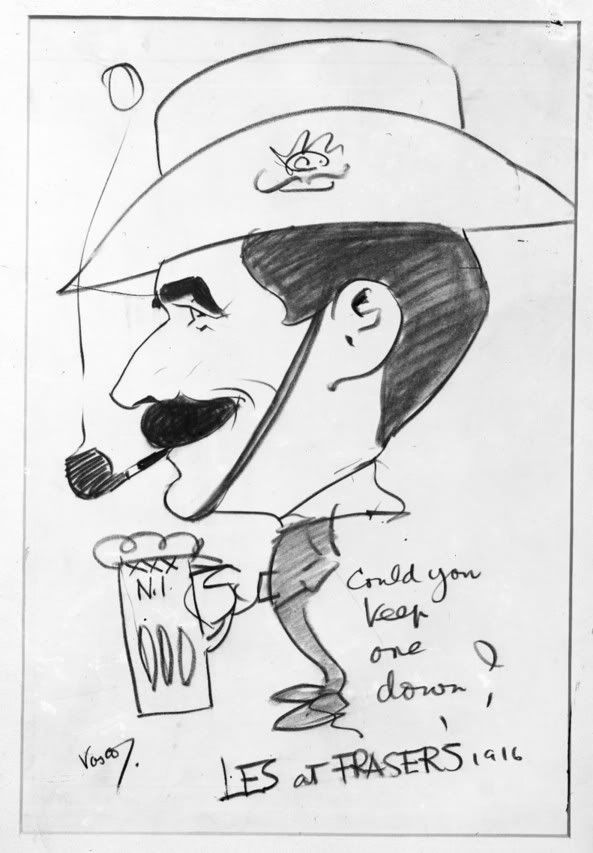
First posted August 2006. Edited 17 March 2010.
I had long thought that this image dated from grandfather's time in basic training at Enoggera Barracks in 1916 as "Fraser's" refers to Fraser's Paddock, one of the four blocks that made up the Enoggera Army establishment.
Who Les was is a matter for the historians, but he was obviously a 'bit of a lad' in order to be immortalised in such a fashion. The moustache, pipe and beer (XXX, if I recall correctly, because XXXX was not yet being produced - I will check and correct if necessary) suggest someone who was worthy of a well-penned cartoon.
The original is a negative image on a glass plate, and this leads me to believe that it was created in order to be used as a cartoon in a newsletter or maybe some form of card or postcard.
The quote "Could you keep one down" is, of course, from the pen of C.J.Dennis in his work Digger Smith, specifically VII. A Digger's Tale. A similar quote appears in Song of a Sentimental Bloke.
Recent research indicates that the artist "Vasco" is actually Vasco Louriero, son of the Portuguese-Australian artist Arthur Loureiro. Vasco enlisted in WW1 in May 1916 (under the name Louis VASCO) in Brisbane, so would have trained at Enoggera, as a Sapper in the Engineers, 12th Field Company.
I still cannot completely explain how "Jack" came into possession of this caricature, but it certainly does seem as if it originated in Fraser's Paddock.
He died of disease (Haemorrhagic pachy-meningitis) following a minor spinal wound in St Albans (Napsbury War Hospital) on 3rd August 1918.
He left little in the way of worldly personal possessions. This image has been lifted from his digitised records at the National Archives of Australia. The items appear to have been placed in the care of the Australian War Memorial.
I have asked the State Library of NSW, which holds some 200+ Vasco drawings, for confirmation of the signature. As of 31 March, I have received no reply.
Labels: 12th Field Company, Arthur Loureiro, Artur Loureiro, Australian War Memorial, Engineers, Enoggera, Fraser's Paddock, Great War, Louis Vasco, Napsbury, Sapper, State Library of NSW, Vasco Loureiro
Sunday, January 11, 2009
Gunner Moody
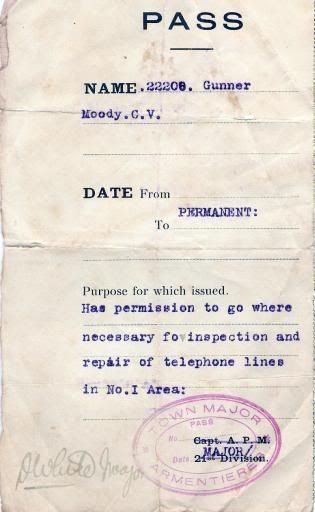 How Jack came to have this pass in his possession, I do not know. He was a fellow artillery signaller, that is clear.
How Jack came to have this pass in his possession, I do not know. He was a fellow artillery signaller, that is clear.Some research at the Australian War Memorial and National Archives websites turned up the following information.
SERN 22208 Clement Vaughan MOODY.
8th Field Artillery Brigade, 30th Battery.
Foster son of Charles and Annie Lawrence, of Bevis St., Adelaide, South Australia. Native of Mount Gambier, South Australia.
Killed in Action 18/10/1917, which was the the day after my Grandfather's 30th birthday.
---------------------------------------------------------
That was some 30 months ago. Today, I looked into the digitised files for Clement Moody at the National archives of Australia. What a sad story they told.
Here is a quick summary. A little boy, 7 years old and with an unmarried mother, is left in the care of an elderly couple whose family had all long ago left home. The mother leaves Adelaide for Perth, promising to send money for his upkeep. She does, for 4 months, then nothing for the next 12 years. The Lawrences have become attached to the lad and raise him as his own. He is contributing his pay of 30 shillings a week to the household when he joins the Army just before his 20th birthday. During his service, Annie Lawrence banks his Army allotment dutifully, awaiting his return. When he is killed in action, his foster parents receive his personal effects and, eventually, his medals and photographs of his grave site from the War Graves Commission. The search begins for his mother, and when she is found she states that the Lawrences can have his medals. Then, comes the problem of the gratuity. As his birth mother is his legal next of kin, and despite a very sympathetic investigation of the circumstances by the Army, his foster parents are deemed not to be eligible for the gratuity, despite the fact that they are 80 years old, receive a weekly pension of 13 shillings, pay 13 shillings in rent, and live off Mr Lawrence's capital of just over 24 pounds. Annie Lawrence still hasn't touched the bank account containing Clement's allotment, now with a balance of over 123 pounds (a lot of money for the early 1920s).
Note (30 March 2010): I have found an account of Gunner Moody's death in the book "Death Sat on a Pale Horse" by Alison Miller, published by Hudson Publishing.
Further investigation into the Red Cross records at the Australian War Museum website shows that Gunner George Ridgway (who was with my grandfather on the day they both won the MM) was a recorded witness to Moody's death. George Ridgeway also witnessed the death of the Red Baron.
See the post in Jack's Diary.
Labels: 30th Battery, 8th FAB, C V Moody, Clement Vaughan Moody, Field Atrillery, Great War, Gunner Moody
Monday, February 05, 2007
Back from leave, luxury (not!) travel.


The cornet referred to above is a Rudall Carte cornet, serial number 6289, that Jack purchased in early 1918.
{6289} (Cornet in B-flat, Patent Conical Bore).
According to the firm's archives [stock books], "Cornet, B-flat, gold-plated; P.C.B."
That is a good description, but does not do justice to the intricate chasing around the bell, and the mother of pearl caps on the valve keys.
" Dear Geoff,
I checked the Rudall Carte stock books in the Boosey and Company and Boosey & Hawkes archives, now located at the Horniman Museum, south London. The cornet was entered in stock 3 Jan 1917; sold 11 Feb 1918 to Cpl. J. Drew 20735 30th Bty A.F.A. France.
It's nice to have such a complete history.
Arnold Myers
Dr Arnold Myers, Director,
Edinburgh University Collection of Historic Musical Instruments,
Reid Concert Hall Museum of Instruments,
Bristo Square, EDINBURGH EH8 9AG, U.K."
The instrument is still in use and, though a little worn and battered after 89 years of playing, quite playable.
Thursday, October 05, 2006
Malta Postcard
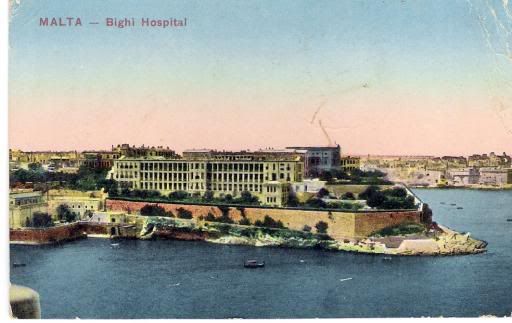
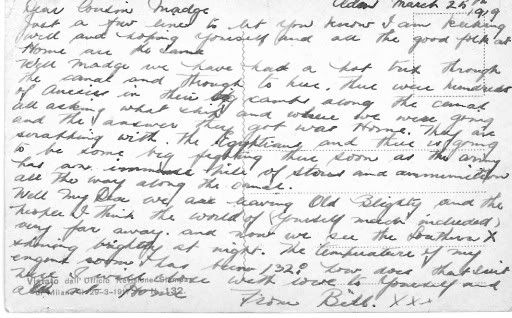 Click on the images to enlarge.
Click on the images to enlarge.I presume that "Bill" is Bill English. The postcard was obtained in Malta, but appears to have been sent from Aden, on the way back to Australia after the cessation of hostilities.
Villers-Brettoneux & Battle of Hamel Christmas & New Year Card
Sent by "Jack" Drew, probably to Madge, in April 1919
Sunday, September 10, 2006
Faces on a Train
 This is obviously in UK somewhere, but not a clue what might be happening. Is this 'the boys' leaving the Codford Camp to start their journeys home to Australia? Or are they just off on an outing somewhere. Can't ask Jack - he's been gone for 21 years!
This is obviously in UK somewhere, but not a clue what might be happening. Is this 'the boys' leaving the Codford Camp to start their journeys home to Australia? Or are they just off on an outing somewhere. Can't ask Jack - he's been gone for 21 years!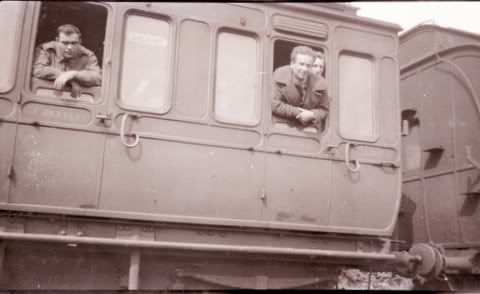
Anyhow, at least one of them looks quite pleased to be going wherever the train is taking them.
Friday, September 08, 2006
Ivanhoe Hotel
 Although there is no date on this receipt, I am guessing that this is the same Ivanhoe Hotel mentioned in the first entry in Jack's Diary, Thursday August 8th 1918 which "... dawned rather wet and dull much to the disappointment of the occupant of room No646." However, the room number on the receipt is 615, so maybe it was from another visit.
Although there is no date on this receipt, I am guessing that this is the same Ivanhoe Hotel mentioned in the first entry in Jack's Diary, Thursday August 8th 1918 which "... dawned rather wet and dull much to the disappointment of the occupant of room No646." However, the room number on the receipt is 615, so maybe it was from another visit.
I suppose that keeping the receipt was a way of remembering his most enjoyable leave with the Dyer family in Pinner. Or maybe he was just a 'bower bird' and kept things like this - I do, too.






